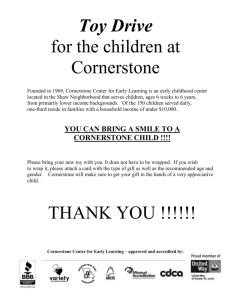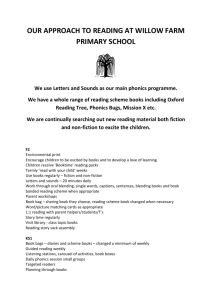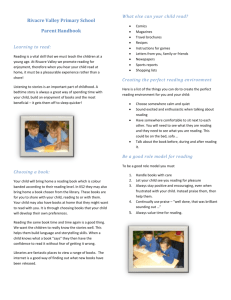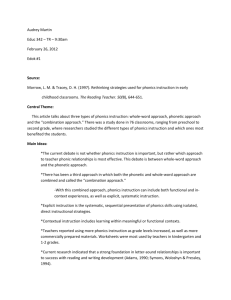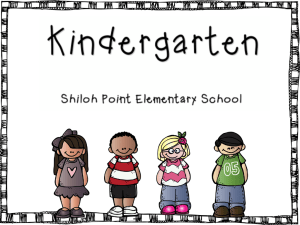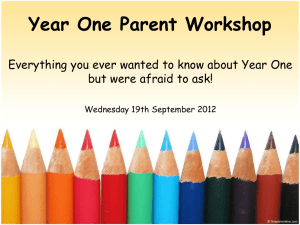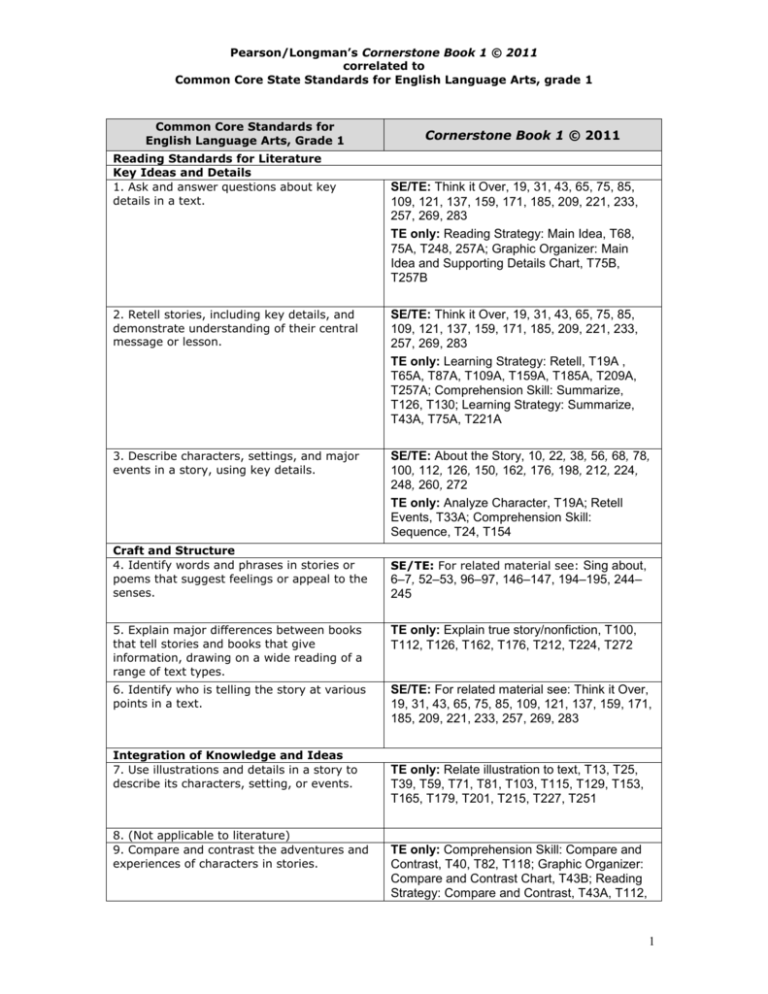
Pearson/Longman’s Cornerstone Book 1 © 2011
correlated to
Common Core State Standards for English Language Arts, grade 1
Common Core Standards for
English Language Arts, Grade 1
Reading Standards for Literature
Key Ideas and Details
1. Ask and answer questions about key
details in a text.
Cornerstone Book 1 © 2011
SE/TE: Think it Over, 19, 31, 43, 65, 75, 85,
109, 121, 137, 159, 171, 185, 209, 221, 233,
257, 269, 283
TE only: Reading Strategy: Main Idea, T68,
75A, T248, 257A; Graphic Organizer: Main
Idea and Supporting Details Chart, T75B,
T257B
2. Retell stories, including key details, and
demonstrate understanding of their central
message or lesson.
SE/TE: Think it Over, 19, 31, 43, 65, 75, 85,
109, 121, 137, 159, 171, 185, 209, 221, 233,
257, 269, 283
TE only: Learning Strategy: Retell, T19A ,
T65A, T87A, T109A, T159A, T185A, T209A,
T257A; Comprehension Skill: Summarize,
T126, T130; Learning Strategy: Summarize,
T43A, T75A, T221A
3. Describe characters, settings, and major
events in a story, using key details.
SE/TE: About the Story, 10, 22, 38, 56, 68, 78,
100, 112, 126, 150, 162, 176, 198, 212, 224,
248, 260, 272
TE only: Analyze Character, T19A; Retell
Events, T33A; Comprehension Skill:
Sequence, T24, T154
Craft and Structure
4. Identify words and phrases in stories or
poems that suggest feelings or appeal to the
senses.
SE/TE: For related material see: Sing about,
6–7, 52–53, 96–97, 146–147, 194–195, 244–
245
5. Explain major differences between books
that tell stories and books that give
information, drawing on a wide reading of a
range of text types.
TE only: Explain true story/nonfiction, T100,
T112, T126, T162, T176, T212, T224, T272
6. Identify who is telling the story at various
points in a text.
SE/TE: For related material see: Think it Over,
19, 31, 43, 65, 75, 85, 109, 121, 137, 159, 171,
185, 209, 221, 233, 257, 269, 283
Integration of Knowledge and Ideas
7. Use illustrations and details in a story to
describe its characters, setting, or events.
8. (Not applicable to literature)
9. Compare and contrast the adventures and
experiences of characters in stories.
TE only: Relate illustration to text, T13, T25,
T39, T59, T71, T81, T103, T115, T129, T153,
T165, T179, T201, T215, T227, T251
TE only: Comprehension Skill: Compare and
Contrast, T40, T82, T118; Graphic Organizer:
Compare and Contrast Chart, T43B; Reading
Strategy: Compare and Contrast, T43A, T112,
1
Common Core Standards for
English Language Arts, Grade 1
Cornerstone Book 1 © 2011
T224, T235A
Range of Reading and Level of Text Complexity
10. With prompting and support, read prose
SE/TE: Sing about, 6–7, 52–53, 96–97, 146–
and poetry of appropriate complexity for
147, 194–195, 244–245; About the Story, 10,
grade 1.
22, 38, 56, 68, 78, 100, 112, 126, 150, 162,
176, 198, 212, 224, 248, 260, 272; Think it
Over, 19, 31, 43, 65, 75, 85, 109, 121, 137,
159, 171, 185, 209, 221, 233, 257, 269, 283
Reading Standards for Informational Text
Key Ideas and Details
1. Ask and answer questions about key
details in a text.
SE/TE: Picture Walk: A Closer Look at, 32–33,
86–87, 122–123, 172–173, 234–235, 284–285;
Think It Over, 109, 121, 171, 185, 221, 233,
283
TE only: Reading strategy & Activity, T109,
T121, T159, T171, T185, T221, T233, T283
2. Identify the main topic and retell key
details of a text.
SE/TE: Picture Walk: A Closer Look at, 32–33,
86–87, 122–123, 172–173, 234–235, 284–285;
Think It Over, 109, 121, 171, 185, 221, 233,
283
3. Describe the connection between two
individuals, events, ideas, or pieces of
information in a text.
SE/TE: Picture Walk: A Closer Look at, 32–33,
86–87, 122–123, 172–173, 234–235, 284–285;
Think It Over, 109, 121, 171, 185, 221, 233,
283
Craft and Structure
4. Ask and answer questions to help
determine or clarify the meaning of words
and phrases in a text.
SE/TE: Prepare to Read, 98–100, 10–112,
160–162, 174–176, 222–224, 270–272
5. Know and use various text features (e.g.,
headings, tables of contents, glossaries,
electronic menus, icons) to locate key facts or
information in a text.
SE/TE: Picture Walk: A Closer Look at, 32–33,
86–87, 122–123, 172–173, 234–235, 284–285
TE only: Understand text structure, T103,
T165, T179, T215, T227, T275
6. Distinguish between information provided
by pictures or other illustrations and
information provided by the words in a text.
SE/TE: Picture Walk: A Closer Look at, 32–33,
86–87, 122–123, 172–173, 234–235, 284–285;
Think It Over, 109, 121, 171, 185, 221, 233,
283
Integration of Knowledge and Ideas
7. Use the illustrations and details in a text to
describe its key ideas.
SE/TE: Picture Walk: A Closer Look at, 32–33,
86–87, 122–123, 172–173, 234–235, 284–285
8. Identify the reasons an author gives to
SE/TE: Think It Over, 109, 121, 171, 185, 221,
2
Common Core Standards for
English Language Arts, Grade 1
Cornerstone Book 1 © 2011
support points in a text.
233, 283
9. Identify basic similarities in and differences
between two texts on the same topic (e.g., in
illustrations, descriptions, or procedures).
SE/TE: Picture Walk: A Closer Look at, 32–33,
86–87, 122–123, 172–173, 234–235, 284–285;
Selections, 101–109, 113–121, 163–171, 177–
185, 225–233, 273–283
Range of Reading and Level of Text Complexity
10. With prompting and support, read
SE/TE: Further reading, 2A–5, 48A–51, 92A–
informational texts appropriately complex for
95, 142A–145, 190A–193, 240A
grade 1.
Reading Standards: Foundational Skills
Print Concepts
1. Demonstrate understanding of the organization and basic features of print.
1a. Recognize the distinguishing features of a
sentence (e.g., first word, capitalization,
ending punctuation).
SE/TE: Your turn: using new words in
sentences, 8, 20, 36, 54, 66, 76, 98, 110, 124,
148, 160, 174, 196, 210, 222, 246, 258, 270;
Reading sentences, 88, 138, 186, 236, 286;
Spelling: capitalize names of celebrations and
traditions, 139
TE only: Identify Letters, Words, and
Sentences, T65D
Phonological Awareness
2. Demonstrate understanding of spoken words, syllables, and sounds (phonemes).
2a. Distinguish long from short vowel sounds
in spoken single-syllable words.
SE/TE: Phonics, 9, 21, 37, 55, 67, 77, 99, 111,
125, 149, 161, 175, 197, 271
2b. Orally produce single-syllable words by
blending sounds (phonemes), including
consonant blends.
SE/TE: Vocabulary, 8, 20, 36, 54, 66, 76, 98,
110, 124, 148, 160, 174, 196, 210, 222, 246,
258, 270; Phonics, 9, 21, 37, 55, 67, 77, 99,
111, 125, 149, 161, 175, 197, 211, 223, 247,
259, 271
2c. Isolate and pronounce initial, medial
vowel, and final sounds (phonemes) in
spoken single-syllable words.
SE/TE: Phonics, 9, 21, 37, 55, 67, 77, 99, 111,
125, 149, 161, 175, 197, 211, 223, 247, 259,
271
2.d Segment spoken single-syllable words
into their complete sequence of individual
sounds (phonemes).
Opportunities to address this objective may be
found on the following pages:
SE/TE: Phonics, 9, 21, 37, 55, 67, 77, 99, 111,
125, 149, 161, 175, 197, 211, 223, 247, 259,
271
Phonics and Word Recognition
3. Know and apply grade-level phonics and word analysis skills in decoding words.
3a. Know the spelling-sound correspondences SE/TE: Phonics ( th (hard and soft), 161
for common consonant digraphs.
3
Common Core Standards for
English Language Arts, Grade 1
Cornerstone Book 1 © 2011
3b. Decode regularly spelled one-syllable
words.
SE/TE: Phonics, 9, 21, 37, 55, 67, 77, 99, 111,
125, 149, 161, 175, 197, 211, 223, 247, 259,
271
3c. Know final -e and common vowel team
conventions for representing long vowel
sounds.
SE/TE: Phonics, 77, 99, 111, 125, 149, 161,
175, 271
3d. Use knowledge that every syllable must
have a vowel sound to determine the number
of syllables in a printed word.
SE/TE: Phonics, 9, 21, 37, 55, 67, 77, 99, 111,
125, 149, 161, 175, 197, 211, 223, 247, 259,
271
TE only: Multisyllabic Words, T159D
3e. Decode two-syllable words following basic
patterns by breaking the words into syllables.
TE only: Multisyllabic Words, T159D
3f. Read words with inflectional endings.
TE only: Multisyllabic Words, T159D
3g. Recognize and read grade-appropriate
irregularly spelled words.
SE/TE: For related material see: Spelling, 45,
89, 187, 237, 287; Vocabulary, 8, 20, 36, 54,
66, 76, 98, 110, 124, 148, 160, 174, 196, 210,
222, 246, 258, 270
Fluency
4. Read with sufficient accuracy and fluency to support comprehension.
4a. Read on-level text with purpose and
TE only: Read Aloud, T10, T22, T38, T56,
understanding.
T68, T78, T100, T112, T126, T150, T162,
T176, T198, T212, T224, T248, T260, T272
4b. Read on-level text orally with accuracy,
appropriate rate, and expression on
successive readings.
TE only: Read Aloud, T10, T22, T38, T56,
T68, T78, T100, T112, T126, T150, T162,
T176, T198, T212, T224, T248, T260, T272
4c. Use context to confirm or self-correct
word recognition and understanding,
rereading as necessary.
SE/TE: Vocabulary, 8, 20, 36, 54, 66, 76, 98,
110, 124, 148, 160, 174, 196, 210, 222, 246,
258, 270
TE only: Reading Strategy, Context Clues,
T100; Comprehension Skill: Context Clues,
T104, T109A, T264
Writing Standards
Text Types and Purposes
1. Write opinion pieces in which they
introduce the topic or name the book they are
writing about, state an opinion, supply a
reason for the opinion, and provide some
sense of closure.
SE/TE: Writing: Persuasive Writing, 286–287
TE only: Writing: Persuasive Writing, T269D,
T285D
2. Write informative/explanatory texts in
which they name a topic, supply some facts
SE/TE: Practice Writing: Compare and
Contrast writing, 236–237; Expository Writing,
4
Common Core Standards for
English Language Arts, Grade 1
about the topic, and provide some sense of
closure.
3. Write narratives in which they recount two
or more appropriately sequenced events,
include some details regarding what
happened, use temporal words to signal event
order, and provide some sense of closure.
Production and Distribution of Writing
4. (Begins in grade 3)
5. With guidance and support from adults,
focus on a topic, respond to questions and
suggestions from peers, and add details to
strengthen writing as needed.
6. With guidance and support from adults,
use a variety of digital tools to produce and
publish writing, including in collaboration with
peers.
Cornerstone Book 1 © 2011
138–139; Informational Writing, 186–187;
Writing activities: write about favorite plant,
187; write about a plant or animal, 188;
compare your family with your partner’s, 237;
write about what is good about America, 238
TE only: Writing: Compare and Contrast
Writing, T209D, T221D, T235D; Writing:
Informational Writing, T159D, T171D, T185D;
Writing: Expository Writing, T109D, T121D,
T137D
SE/TE: Narrative Writing, 88–89; Writing: write
a story about our flag, 123; write a story about
a friend, 46; write a narrative about what you
do in your community, 89
TE only: Writing: Narrative Writing, T65D,
T73D, T87D
SE/TE: Write!, 45, 89, 139, 187, 237, 287;
Writing Activities, 46, 87, 89, 90, 123, 139, 140,
187, 188, 237, 238, 287, 288
SE/TE: Write!, 45, 89, 139, 187, 237, 287;
Writing Activities, 46, 87, 89, 90, 123, 139, 140,
187, 188, 237, 238, 287, 288
Research to Build and Present Knowledge
7. Participate in shared research and writing
projects (e.g., explore a number of “how-to”
books on a given topic and use them to write
a sequence of instructions).
SE/TE: Informational Writing, 186–187; Writing
activities: write about favorite plant, 187; write
about a plant or animal, 188; compare your
family with your partner’s, 237; write about
what is good about America, 238
8. With guidance and support from adults,
recall information from experiences or gather
information from provided sources to answer
a question.
SE/TE: Write!, 45, 89, 139, 187, 237, 287;
Writing Activities, 46, 87, 89, 90, 123, 139, 140,
187, 188, 237, 238, 287, 288
9. (Begins in grade 4)
Range of Writing
10. (Begins in grade 3)
Speaking and Listening Standards
Comprehension and Collaboration
1. Participate in collaborative conversations with diverse partners about grade 1 topics and
texts with peers and adults in small and larger groups.
1a. Follow agreed-upon rules for discussions
SE/TE: Let’s Talk, 3, 49, 93, 143, 191, 241;
(e.g., listening to others with care, speaking
What do you know: tell about it, 4–5, 50–51,
one at a time about the topics and texts
94–95, 144–145, 192–193, 242–243
under discussion).
5
Common Core Standards for
English Language Arts, Grade 1
Cornerstone Book 1 © 2011
1b. Build on others’ talk in conversations by
responding to the comments of others
through multiple exchanges.
SE/TE: Let’s Talk, 3, 49, 93, 143, 191, 241;
What do you know: tell about it, 4–5, 50–51,
94–95, 144–145, 192–193, 242–243
1c. Ask questions to clear up any confusion
about the topics and texts under discussion.
SE/TE: Let’s Talk, 3, 49, 93, 143, 191, 241;
What do you know: tell about it, 4–5, 50–51,
94–95, 144–145, 192–193, 242–243
2. Ask and answer questions about key
details in a text read aloud or information
presented orally or through other media.
SE/TE: Let’s Talk, 3, 49, 93, 143, 191, 241
TE only: Assess, T19, T31, T43, T65, T75,
T85, T109, T121, T137, T159, T171, T185,
T209, T221, T233, T257, T269, T283
3. Ask and answer questions about what a
speaker says in order to gather additional
information or clarify something that is not
understood.
SE/TE: Let’s Talk, 3, 49, 93, 143, 191, 241;
What do you know: tell about it, 4–5, 50–51,
94–95, 144–145, 192–193, 242–243
TE only: Assess, T19, T31, T43, T65, T75,
T85, T109, T121, T137, T159, T171, T185,
T209, T221, T233, T257, T269, T283
Presentation of Knowledge and Ideas
4. Describe people, places, things, and events
with relevant details, expressing ideas and
feelings clearly.
SE/TE: Let’s Talk, 3, 49, 93, 143, 191, 241;
Oral Activities, 47, 91, 141, 189, 239, 289
TE only: Oral Presentation, T43B, T43D,
T87B, T87D, T137B, T137D, T185B, T209B,
T209D, T235B, T235D, T285B, T285D
5. Add drawings or other visual displays to
descriptions when appropriate to clarify ideas,
thoughts, and feelings.
Opportunities to address this objective may be
found on the following pages:
SE/TE: Let’s Talk, 3, 49, 93, 143, 191, 241;
Oral Activities, 47, 91, 141, 189, 239, 289
TE only: Oral Presentation, T43B, T43D,
T87B, T87D, T137B, T137D, T185B, T209B,
T209D, T235B, T235D, T285B, T285D;
Assess, T19, T31, T43, T65, T75, T85, T109,
T121, T137, T159, T171, T185, T209, T221,
T233, T257, T269, T283
6. Produce complete sentences when
appropriate to task and situation. (See grade
1 Language standards 1 and 3 on page 26 for
specific expectations.)
SE/TE: Let’s Talk, 3, 49, 93, 143, 191, 241;
Oral Activities, 47, 91, 141, 189, 239, 289
TE only: Oral Presentation, T43B, T43D,
T87B, T87D, T137B, T137D, T185B, T209B,
T209D, T235B, T235D, T285B, T285D;
Assess, T19, T31, T43, T65, T75, T85, T109,
T121, T137, T159, T171, T185, T209, T221,
T233, T257, T269, T283
6
Common Core Standards for
English Language Arts, Grade 1
Cornerstone Book 1 © 2011
Language Standards
Conventions of Standard English
1. Demonstrate command of the conventions of standard English grammar and usage when
writing or speaking.
1a. Print all upper- and lowercase letters.
SE/TE: Write! 45, 89, 139, 187, 237, 287
1b. Use common, proper, and possessive
nouns.
TE only: Handwriting Practice, T45, T89,
T139, T187, T237, T287
SE/TE: Grammar: Nouns, T65C, T109C; Plural
Nouns: -s, -es, 1121C; Proper Nouns, T73C
1c. Use singular and plural nouns with
matching verbs in basic sentences (e.g., He
hops; We hop).
TE only: Grammar: Nouns, T65C, T109C;
Plural Nouns: -s, -es, 1121C
1d. Use personal, possessive, and indefinite
pronouns (e.g., I, me, my; they, them, their;
anyone, everything).
TE only: Grammar: Pronouns, T87C, 257C
1e. Use verbs to convey a sense of past,
present, and future (e.g., Yesterday I walked
home; Today I walk home; Tomorrow I will
walk home).
SE/TE: For related material see: Write!, 45, 89,
139, 187, 237, 287
1f. Use frequently occurring adjectives.
TE only: Grammar: Adjective, T19D, T33D,
T43D; Describing Words, T209C
1g. Use frequently occurring conjunctions
(e.g., and, but, or, so, because).
SE/TE: For related material see: Write! 45, 89,
139, 187, 237, 287
1h. Use determiners (e.g., articles,
demonstratives).
SE/TE: For related material see: Write! 45, 89,
139, 187, 237, 287
1i. Use frequently occurring prepositions
(e.g., during, beyond, toward).
SE/TE: For related material see: Write! 45, 89,
139, 187, 237, 287
1j. Produce and expand complete simple and
compound declarative, interrogative,
imperative, and exclamatory sentences in
response to prompts.
SE/TE: Write!, 45, 89, 139, 187, 237, 287
TE only: Grammar: Asking and Telling
Sentences, T137C; Grammar: Asking
Sentences with What, T43C
2. Demonstrate command of the conventions of standard English capitalization, punctuation,
and spelling when writing.
2a. Capitalize dates and names of people.
SE/TE: Spelling: capitalize names of
celebrations and traditions, 139; also see:
Writing practice and handwriting model, 45, 89,
139, 187, 237, 287
2b. Use end punctuation for sentences.
SE/TE: Exclamation Point, T74, T103;
Grammar: Asking and Telling Sentences,
T137C; Grammar: Asking Sentences with
What, T43C
7
Common Core Standards for
English Language Arts, Grade 1
Cornerstone Book 1 © 2011
2c. Use commas in dates and to separate
single words in a series.
SE/TE: For related material see: Write a Letter
to a Friend, 87
2d. Use conventional spelling for words with
common spelling patterns and for frequently
occurring irregular words.
SE/TE: For related material see: Spelling, 45,
89, 187, 237, 287; Vocabulary, 8, 20, 36, 54,
66, 76, 98, 110, 124, 148, 160, 174, 196, 210,
222, 246, 258, 270
2e. Spell untaught words phonetically,
drawing on phonemic awareness and spelling
conventions.
SE/TE: For related material see: Spelling, 45,
89, 187, 237, 287; Vocabulary, 8, 20, 36, 54,
66, 76, 98, 110, 124, 148, 160, 174, 196, 210,
222, 246, 258, 270; Phonics, 9, 21, 37, 55, 67,
77, 99, 111, 125, 149, 161, 175, 197, 211, 223,
247, 259, 271
Knowledge of Language
3. (Begins in grade 2)
Vocabulary Acquisition and Use
4. Determine or clarify the meaning of unknown and multiple-meaning words and phrases
based on grade 1 reading and content, choosing flexibly from an array of strategies.
4a. Use sentence-level context as a clue to
SE/TE: Vocabulary, 8, 20, 36, 54, 66, 76, 98,
the meaning of a word or phrase.
110, 124, 148, 160, 174, 196, 210, 222, 246,
258, 270
TE only: Reading Strategy, Context Clues,
T100; Comprehension Skill: Context Clues,
T104, T109A, T264
4b. Use frequently occurring affixes as a clue
to the meaning of a word.
SE/TE: For related material see: Grammar:
4c. Identify frequently occurring root words
(e.g., look) and their inflectional forms (e.g.,
looks, looked, looking).
SE/TE: Grammar: Plural Nouns: -s, -es,
Plural Nouns: -s, -es, 1121C
1121C
5. With guidance and support from adults, demonstrate understanding of word relationships
and nuances in word meanings.
5a. Sort words into categories (e.g., colors,
SE/TE: Vocabulary, 8, 20, 36, 54, 66, 76, 98,
clothing) to gain a sense of the concepts the
110, 124, 148, 160, 174, 196, 210, 222, 246,
categories represent.
258, 270
TE only: Rhyming Words, T109D; Counting
Words, T171; Describing Words, T209C
5b. Define words by category and by one or
more key attributes (e.g., a duck is a bird
that swims; a tiger is a large cat with stripes).
SE/TE: Vocabulary, 8, 20, 36, 54, 66, 76, 98,
110, 124, 148, 160, 174, 196, 210, 222, 246,
258, 270
TE only: Rhyming Words, T109D; Counting
Words, T171; Describing Words, T209C
8
Common Core Standards for
English Language Arts, Grade 1
Cornerstone Book 1 © 2011
5c. Identify real-life connections between
words and their use (e.g., note places at
home that are cozy).
SE/TE: Vocabulary: Words to Know, 8, 20, 36,
54, 66, 76, 98, 110, 124, 148, 160, 174, 196,
210, 222, 246, 258, 270
5d. Distinguish shades of meaning among
verbs differing in manner (e.g., look, peek,
glance, stare, glare, scowl) and adjectives
differing in intensity (e.g., large, gigantic) by
defining or choosing them or by acting out
the meanings.
SE/TE: For related material see: Vocabulary,
6. Use words and phrases acquired through
conversations, reading and being read to, and
responding to texts, including using
frequently occurring conjunctions to signal
simple relationships (e.g., because).
SE/TE: For related material see: Vocabulary,
8, 20, 36, 54, 66, 76, 98, 110, 124, 148, 160,
174, 196, 210, 222, 246, 258, 270
8, 20, 36, 54, 66, 76, 98, 110, 124, 148, 160,
174, 196, 210, 222, 246, 258, 270
9

